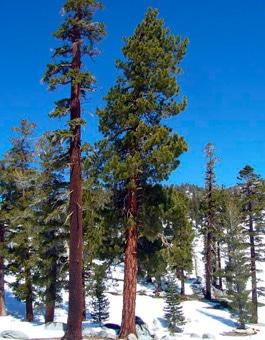

Protecting our water source
The California red fir often dominates large areas of high country that are a major watershed, particularly in California. For this reason it has long been an important forest tree.The name red fir derives from the bark color of old trees. The wood is straight-grained, light and soft but stronger than the wood of other firs. It is used for fuel, coarse lumber, quality veneer, solid framing, plywood and printing paper.
Range
The California red fir is native to the mountains of southwest Oregon and California. It is a high-elevation tree, typically occurring at elevations of between 4,600 and 8,900 feet, though rarely reaching the tree line.
Character
This species has a narrow conical crown with horizontal branches and flattened needles, about 1 inch long, resembling a hockey stick. Male cones are purple to dark red and female cones are reddish-brown and located near the top of the crown.
Understory
Dense red fir stands on good-quality sites usually have no understory vegetation.
Climate
Climate for the red fir is relatively mild for high-elevation forests, with summer temperatures only occasionally exceeding 85°F and winter temperatures rarely below -29°F. Best growth appears to be in areas that receive between 30 and 49 inches of precipitation annually.
Management
The California red fir is a climax species nearly everywhere it is found, maturing in approximately 140 years. It is responsible for much of the timber volume in California, but is less accessible in the high altitudes of the Siskiyou and Cascades ranges in Oregon where harvesting is minimal.